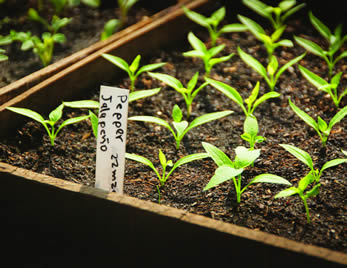How to Grow Seedlings Indoors
A good habit is to sow only part of your seed at first, saving the rest to plant a week or two later. That way, if the seeds come to harm in some way, you still have some. And when harvest time comes, you won’t have all your produce at once, but can pick over a long period. This is referred to in books and catalogs as “succession-sowing” Garden crops need much brighter light than most houseplants. A sunny window will work, if all the seedlings can get light—you may have to turn the flat often. If the window “almost works” but is not quite enough, consider hanging a light just over the plants. A compact florescent (larger size) in a cheap “droplight” could be just the boost they need. Many gardeners will need to use mostly artificial light. A florescent “shop light” or “grow light” fixture is not very expensive, uses little power, and works well as long as it is close to the plants—light loses strength quickly with distance. Hang your light on adjustable chain or cord so that it can start 4-6" from the soil, and raise it as the plants grow (or start by putting the plants on blocks and lower them.) Plants that are tall and thin, with lots of stem between leaves, need more light. If a plant gets bleached leaves, the light is too close. Growth should be continuous—if it slows, feed with compost tea or other mild liquid fertilizer. Check to see that roots have not filled the pot. Once seedlings are as tall as the pot is deep and have several pairs of leaves, they should be transplanted to a larger container or into the garden. If seedlings appear withered at soil level and fall over, they’ve been attacked by fungi and will not recover. This is a called damping off. Here’s how to prevent it:
For about a week before transplanting to the garden the seedlings need to be “hardened off.” Set them outside an hour or two at mid-day at first, gradually lengthening into the cooler morning and evening hours. Make sure they don’t dry out and protect them from wind and critters. Or put them in a cold frame and open the lid longer each day. For an easy way to harden off seedlings and get a jump on the season, you can also use glass or plastic jugs with the bottom cut out placed over the plant. These are called cloches. (You can also make little plastic tents over them). Much greater protection from frost and cold is attained by using water to store the day’s heat and use it to warm the plant at night. You can use plastic bottles of water to surround your seedlings, or put bigger containers of water inside your coldframe, hoophouse, row cover, or other enclosure. It is quite amazing how much more growth plants can make with water around them to store the day’s heat and radiate it at night. ♥ top | Newsletter Home |Table of Contents| Archive
|


 Tomatoes, peppers, eggplant, and onions need to be started at least 2 months before you want to put them outside—March is good in most of the US. Melons, cucumbers, squashes, basil, okra, and sunflowers (as well as chia and quinoa in some places) can be started a month before planting out. Beans and corn should be sown direct in the garden or about 2 weeks before putting outside. Germinate seeds at 65 to 75 degrees F. Tomatoes, peppers, melons, eggplant, and basil will germinate best with additional heat, such as the special plant heat mats you can get at the garden store. The top of a refrigerator, gas stove with a pilot light, or any electric appliance that is on for long period will often add just enough extra. You don't need anything above room temperature once leaves appear. Make a soil mix from garden soil, sand, and compost in roughly equal parts (or if you don't have the materials to make your own, buy a high-quality one from a reputable garden supply. Price is a good indicator of quality in potting soil.) Soil should be moist but not wet. We recommend using a fungal inoculant in your soil mix to prevent damping off, help the seedlings grow faster, and extend the roots’ ability to find nutrients and water.
Tomatoes, peppers, eggplant, and onions need to be started at least 2 months before you want to put them outside—March is good in most of the US. Melons, cucumbers, squashes, basil, okra, and sunflowers (as well as chia and quinoa in some places) can be started a month before planting out. Beans and corn should be sown direct in the garden or about 2 weeks before putting outside. Germinate seeds at 65 to 75 degrees F. Tomatoes, peppers, melons, eggplant, and basil will germinate best with additional heat, such as the special plant heat mats you can get at the garden store. The top of a refrigerator, gas stove with a pilot light, or any electric appliance that is on for long period will often add just enough extra. You don't need anything above room temperature once leaves appear. Make a soil mix from garden soil, sand, and compost in roughly equal parts (or if you don't have the materials to make your own, buy a high-quality one from a reputable garden supply. Price is a good indicator of quality in potting soil.) Soil should be moist but not wet. We recommend using a fungal inoculant in your soil mix to prevent damping off, help the seedlings grow faster, and extend the roots’ ability to find nutrients and water.